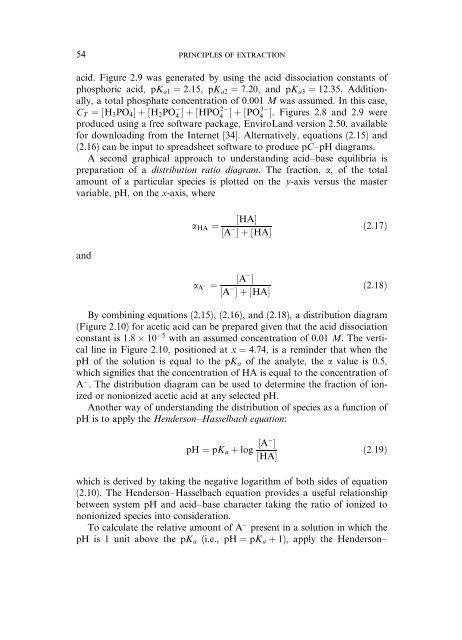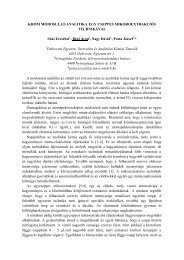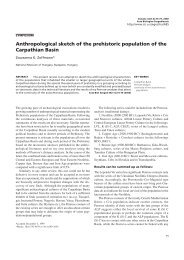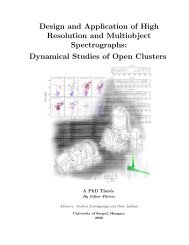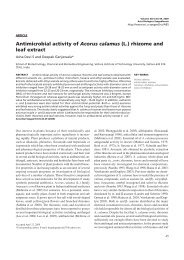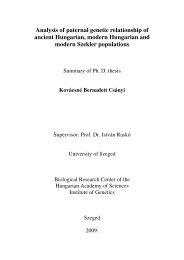principles of extraction and the extraction of semivolatile organics ...
principles of extraction and the extraction of semivolatile organics ...
principles of extraction and the extraction of semivolatile organics ...
Create successful ePaper yourself
Turn your PDF publications into a flip-book with our unique Google optimized e-Paper software.
54 <strong>principles</strong> <strong>of</strong> <strong>extraction</strong><br />
acid. Figure 2.9 was generated by using <strong>the</strong> acid dissociation constants <strong>of</strong><br />
phosphoric acid, pKa1 ¼ 2:15, pKa2 ¼ 7:20, <strong>and</strong> pKa3 ¼ 12:35. Additionally,<br />
a total phosphate concentration <strong>of</strong> 0.001 M was assumed. In this case,<br />
CT ¼½H3PO4Šþ½H2PO4 Šþ½HPO 2<br />
4 Šþ½PO3 4 Š. Figures 2.8 <strong>and</strong> 2.9 were<br />
produced using a free s<strong>of</strong>tware package, EnviroL<strong>and</strong> version 2.50, available<br />
for downloading from <strong>the</strong> Internet [34]. Alternatively, equations (2.15) <strong>and</strong><br />
(2.16) can be input to spreadsheet s<strong>of</strong>tware to produce pC–pH diagrams.<br />
A second graphical approach to underst<strong>and</strong>ing acid–base equilibria is<br />
preparation <strong>of</strong> a distribution ratio diagram. The fraction, a, <strong>of</strong> <strong>the</strong> total<br />
amount <strong>of</strong> a particular species is plotted on <strong>the</strong> y-axis versus <strong>the</strong> master<br />
variable, pH, on <strong>the</strong> x-axis, where<br />
<strong>and</strong><br />
aHA ¼<br />
aA ¼<br />
½HAŠ<br />
½A Šþ½HAŠ<br />
½A Š<br />
½A Šþ½HAŠ<br />
ð2:17Þ<br />
ð2:18Þ<br />
By combining equations (2.15), (2.16), <strong>and</strong> (2.18), a distribution diagram<br />
(Figure 2.10) for acetic acid can be prepared given that <strong>the</strong> acid dissociation<br />
constant is 1:8 10 5 with an assumed concentration <strong>of</strong> 0.01 M. The vertical<br />
line in Figure 2.10, positioned at x ¼ 4:74, is a reminder that when <strong>the</strong><br />
pH <strong>of</strong> <strong>the</strong> solution is equal to <strong>the</strong> pKa <strong>of</strong> <strong>the</strong> analyte, <strong>the</strong> a value is 0.5,<br />
which signifies that <strong>the</strong> concentration <strong>of</strong> HA is equal to <strong>the</strong> concentration <strong>of</strong><br />
A . The distribution diagram can be used to determine <strong>the</strong> fraction <strong>of</strong> ionized<br />
or nonionized acetic acid at any selected pH.<br />
Ano<strong>the</strong>r way <strong>of</strong> underst<strong>and</strong>ing <strong>the</strong> distribution <strong>of</strong> species as a function <strong>of</strong><br />
pH is to apply <strong>the</strong> Henderson–Hasselbach equation:<br />
pH ¼ pKa þ log<br />
½A Š<br />
½HAŠ<br />
ð2:19Þ<br />
which is derived by taking <strong>the</strong> negative logarithm <strong>of</strong> both sides <strong>of</strong> equation<br />
(2.10). The Henderson–Hasselbach equation provides a useful relationship<br />
between system pH <strong>and</strong> acid–base character taking <strong>the</strong> ratio <strong>of</strong> ionized to<br />
nonionized species into consideration.<br />
To calculate <strong>the</strong> relative amount <strong>of</strong> A present in a solution in which <strong>the</strong><br />
pH is 1 unit above <strong>the</strong> pKa (i.e., pH ¼ pKa þ 1), apply <strong>the</strong> Henderson–


